|
BOB WOLFF
A Scouter's Life
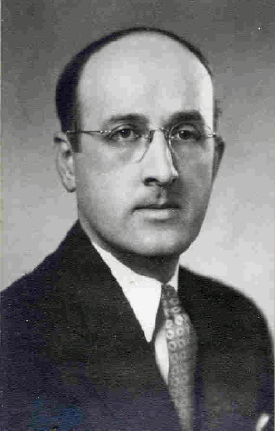
By Helen Wolff, March 1994
Additions by Marty Tschetter, November 2007
|
|
|
This tribute to the genuineness of
Bob Wolff's spirit has been prepared twenty-five years after his death.
As his wife I was motivated to write this when repeatedly asked by
Wayne Farrar, the initiator and director of the Hammerstone Scout
Museum, to give or loan to the museum memoribilia of Bob's life. When I
visited the museum in February 1994, Wayne told me that his information
about Bob was primarily from hearing Scouters talk about him. "Bob's
name comes up over and over again and I need a biography," he told me.
When
I returned home and went through all the things, which I had saved and
put away "for a later time." I knew that the time had come to record
the facts as I understood them. The work has served as a catharsis, in
that I have relived painful memories, as well as enjoyed, laughed and
felt more deeply the sheer goodness of the man who had been my husband
for twenty-five years.
|
|
|
|
Robert Lee Wolff, Jr., son of Robert Lee Wolff and Alice Booker Wolff,
was born January 24, 1915 in Greensboro, North Carolina. His parents
were from Pinnacle, located in Surry County, North Carolina. It was
there that his paternal grandparents, Dr. Nathaniel A. Wolff and
Alethea Gordon Wolff had lived from 1830 to the early 1900's. His
parents were in 1900 and moved to Guilford County in December 1911. Mr.
Wolff purchased the historical house built in the 1850's by Robert C.
Caldwell, son of Dr. David Caldwell. Know as the "The Black House." it
was on Friendly Road about three miles west of Greensboro and near
Guilford College. Here Robert and Alice lived with their six children:
William, Edward, George, Julia, Dorothy, and Robert, Jr.
Bob was seven years old when his father died in 1922 after a prolonged illness. The Greensboro Daily News
account of Mr. Wolff's stated: "He was one of the country's foremost
farmers and was held in highest personal regard by all who knew him. He
had the confidence of the general public as few mem of today can claim.
He was an educated man and an earnest reader. It may be said of him
that he was the most scientific and intensive farmers of the community."
It
is noteworthy that each of his children valued an education and became
well educated people. William earned a Ph.D. in Chemistry. Edward
attended North Carolina State College for two years. George graduated
from high school and immediately began working. Dorothy received a B.S.
degree from Guilford College and was a high school biology teacher.
Julia received an A.B. degree from Guilford College and did graduate
work at Bryn Mawr. She taught high school English. Mrs. Wolff remained
in the home until her death in 1941.
Bob
attended elementary school at Guilford College. At age 12 he became a
Boy Scout. Growing up in the country and encourgaged by his mother, he
learned as a youngster to love and revere all living creatures, plants,
and the earth itself. He acquired an amazing amount of knowledge
through observation and reading. His particular interest in birds was
well developed when he attended Greensboro Senior High School (later
Grimsley High School), as evidenced by a paper he wrote for an English
class titled "A Beginner's Obeservations of Bird Life." The paper
earned an A- from Miss Laura Tillett, his renowned teacher.
|
|
Camp Lenape, Burlington County Council, New Jersey
|
|
|
After graduating from high school in 1932, he attended the University
of Pennsylvania. His brother William was on the faculty of the medical
school and Bob lived with his and his wife Mabel. His Scouting interest
continued there as he served as an Assistant Scoutmaster and was the
nature counselor at the Boy Scout camp of Burlington County, New Jersey
for three years.
His
first year as a counselor he was voted by the campers as the best-liked
staff member. His writing to his mother about this, he said "I think it
was because I am a Southern Boy." In the same letter he told how
embarrassed he was because when his sister Dot came to see him, she
said "O'mah honey chile, I certainly is glad to see ya!" Some of the
staff and campers heard her and after that they greeted him with "O'may
honey chile." His description of all the nature activities he directed
indicates that his popularity was earned of this creative work rather
than his Southern dialect.
Bob was intiated into Hunnikick Lodge #76 during the 1934 camp season
for the Burlington County Council in New Jersey. In
Philadelphia he was also a Neighborhood Committeman for two years.
Notes and correspondance show that he and his friends explored many
nature areas in the vincinity and took many bird trips. Bob's
pre-medical work at the university was halted because he lost all
vision in his left eye. This tradegy brought him back to North Carolina
where he enrolled at the University of North Carolina, where he
earned a certificate of public health in 1938.
|
|
|
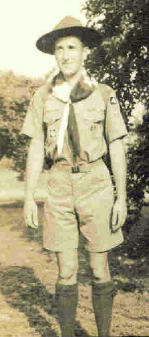
Robert Lee Wolff, Jr.
Camp Lenape, New Jersey
1934
Courtesy of the
Hammerstone Scout Museum
Lillington, NC
|
|
Camp Greystone, Greensboro Council, North Carolina
|
|
|
Bob's early Scouting years were greatly enriched by time spent camping at Camp Greystone of the Greensboro Council. These experiences contributed to his achievement of the Eagle Scout rank. There are indications that he also served as the nature counselor at Graystone while he was in high school. Later when he was on the staff he composed "The Legend of the Greystone," which was passed on year after year to the boys and men who camped there.
|
|
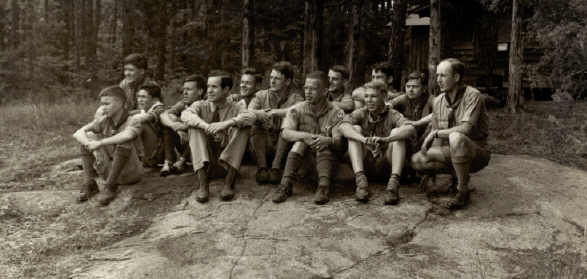
Scouts on Greystone Rock, Camp Greystone
Far Right: Robert Wolff
Tali Taktaki History File
Old North State Council, Greensboro, North Carolina
|
|
|
1937 World Jamboree, Holland
|
|
|
One of the most exciting and interesting experiences of Bob's life
occurred in 1937 when he was selected to be a member of the staff of
the World Jamboree in Holland. He led a group of seven boys from
Greensboro to the National Jamboree in Washington, DC and then on to
Europe.
|
|
|
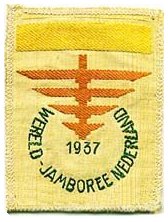
|
In a letter to his mother he wrote:
"There
were 25,000 Scouts at the Jamboree and 43 countries represented. It was
truly a grand sight to see the flags of the countries massed together
and the thousands of boys marching by the reviewing stand where the
Queen of Holland, Prince of Sweden, Lord Baden-Powell, and our own Dr.
James E. West and others watched...........On one afternoon the
American group demonstrated to a crowd of at least 50,000 the various
phases of Scouting in the U.S.A. Each activity was directed by an
appointed man and of all things I had to direct, it was pioneering.
|
There were about 125 Scouts to direct and as they were willing to
follow, we built a huge bridge, about 40 feet long and 15 feet high. We
also built a smaller bridge and two towers about 20 feet high each, all
being completed in 8 minutes."
"The
rest of the demonstrations consisted of Scout games, signaling, first
aid projects, and special camping scenes where tents were erected and
fires built....I had a most wonderful time and made many friends from
various countries."
The
correspondence which Robert carried on with these new Scout friends
continued into World War II. Letters from Sweden, Norway, Finland,
Holland, Northern Ireland, Scottland, Nassau, and Brazil are on loan to
the Hammerstone Scout Museum in Lillington. The Greensboro Scouts
toured France, Switzerland, Brussells, and England. His letters to his
mother are actually like a diary of the entire trip.
|
|
|
1938 National OA Meeting
Irondale Scout Reservation, St. Louis, Missouri
|
| Tali Taktaki sent six delegates to the national meeting held at Irondale Scout Reservation. This was the only group from Region Six to attend. Wolff and Frank Dix received the Brotherhood honor at this fellowship, the first recipients in Region Six. |
|
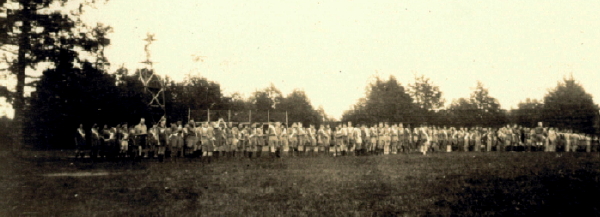
"Colors"
Tali Taktaki History File
Old North State Council, Greensboro, North Carolina
|
|
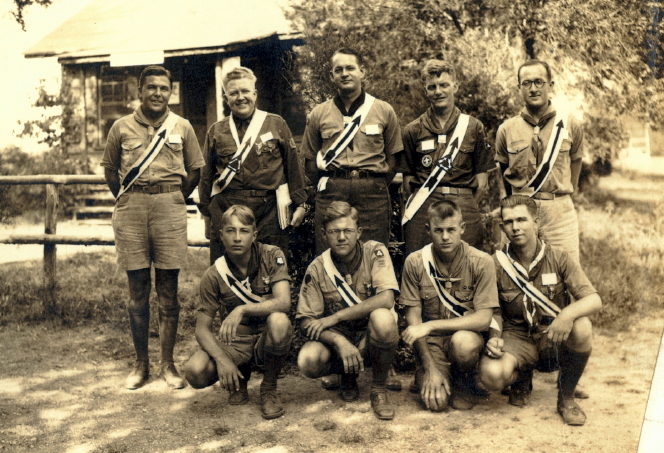
Top row, left to right: Frank Dix, Lloyd Nelson, Frank Braden, Joe Brinton, Bob Wolff.
Bottom row, left to right: Bill Candle, Wade Fox, George Gibbs, Cluade O'Brien.
Tali Taktaki History File
Old North State Council, Greensboro, North Carolina
NOTE:
Frank Dix: first man from Region Six to serve nationally. He received the Vigil Honor in 1947 from Tali Taktaki.
Lloyd Nelson: 1925 Unami Lodge Chief, National Chief 1942-1946, National Committee Chairman 1949-1955.
Frank Braden: Started Cherokee lodge 50, brought the OA to North Carolina in 1933.
Joe Brinton: National Chief 1936-1938.
Claude O'Brien: Early Tali Taktaki lodge chief. |
|
|
|
|
Department of Public Health
|
|
|
|
Following his studies at University of North Carolina, Bob worked with the North
Carolina Department of Public Health. This took him to several areas of
the state. Time was spent in Lumberton, Bryson City, and Leaksville and
other areas. While in Bryson City, he worked with the Cherokees, where
he served as an assistant Scoutmaster. The Cherokee Council presented
to him the Acorn Award for his service. He enjoyed being with the
Cherokees very much and often spoke of things he learned from them.
|
|
Scout Executive Commission
|
Bob was greatly concerned that he was unable to serve in the Second
World War due to his 4F classication. Many of his friends were serving
and he had a strong desure to be engaged in the war with them. His
disappointment was somewhat mitigated when in 1941 he accepted a
request by the Greensboro Area Boy Scout Council to serve as assistant
Scout executive. This appointment meant he had to leave public health
work and take the National Training Course for Scout Executives at the
Schiff Scout Reservation in Mendham, New Jersey. He completed the
training April 30th, 1941. In the overall appraisal ranking in a class
of thirty men, his rank was number one. He was selected permanent
patrol leader of the class. His highest scores were on adaptability,
sociability, tact, and sense of humor, followed closely by Scouting
spirit, leadership of men and originality. His lowest score was
punctuality!
His
tenure with the Greensboro Council was from 1941 to April 1943. He was
then sought by the Tuscorora Council based in Goldsboro. He accepted
their invitation and served as Scout Executive through December 1948.
He and Helen Donavant were married in April 1945. Helen was also from
Greensboro and served as field secretary of the Greensboro Girl Scout
Council for two years prior to their marriage.
While
in Goldsboro, Bob's outstanding accomplishments were in the areas of
camping, training of leaders and troop activities. However, he did not
enjoy the executive role as it related to fund raising and office
management. Bob excelled in directing Scout program of exceedingly high
quality. He believed strongly in the values inculated in the regular
Scout program and in the Order of the Arrow program.
He
was the founder of the Nay-Win-Rar Lodge #296 in the Tuscarora Council
in 1943. He was also active in assisting other lodges throughout the
North Carolina and other states. He helped initiate annual state
meetings and was involved in several national OA meetings.
|
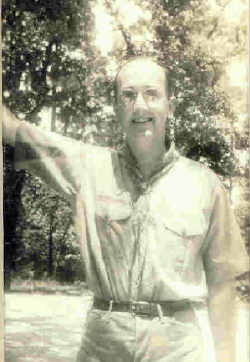
Tuscorara Council Scout Executive
Circa 1945
Courtesy of the
Hammerstone Scout Museum
Lillington, NC
|
|
Early National Distinguished Service Award Recipient
|
|
The national committee of the Order of the Arrow selected Wolff to receive the Distinguished Service
Award in 1946. Due to a professional conflict, Wolff was unable to receive the award in person. However, requested that it not be awarded through the Boy
Scout Council but sent directly to him. However, Judge Paul Edmundson
who was council president, was requested by the national OA executive
committee to make the presentation. Ironically, at the time of the acknowledgement Wolff was only a Brotherhood member.
Bob's request not to receive any
public recognition was typical of his attitude about his
accomplishments. Essential, he was a very modest person. He was also a
person who seldom shared his personal feelings, but was adept at being
a good listener and "bringing out the best in others."
|
|
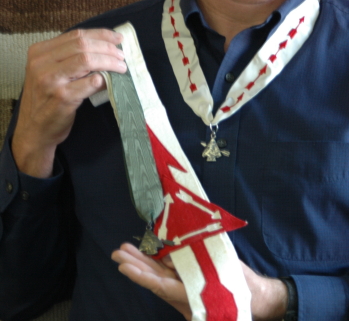
Dr. Roger Billica (DSA Class of 1975) holding Bob Wolff's
Distinguished Service Award and felt Vigil Honor sash
At the time of Wolff's selection, there were only twenty recipients, including Goodman and Edson. The green ribbon was presented through 1963 representing the "Great Outdoors." The ribbon was changed to white with red arrows in 1967.
|
|
1946 North Carolina State OA Meeting
|
|
Bob Wolff had been an advocate to other councils throughout the South of the important contributions a lodge could make to summer camp program. He played an integral role starting several lodges throughout the South, as well as, had an active role statewide OA fellowships held in 1940, 1942, 1945, and 1946. After the National OA Committee bestowed the DSA for his contributions, he received the Vigil Honor at the state meeting later that fall.
At this time in the Order, candidates would select their own Vigil name, which Wolff spent thoughtful time researching a "good fit."
|
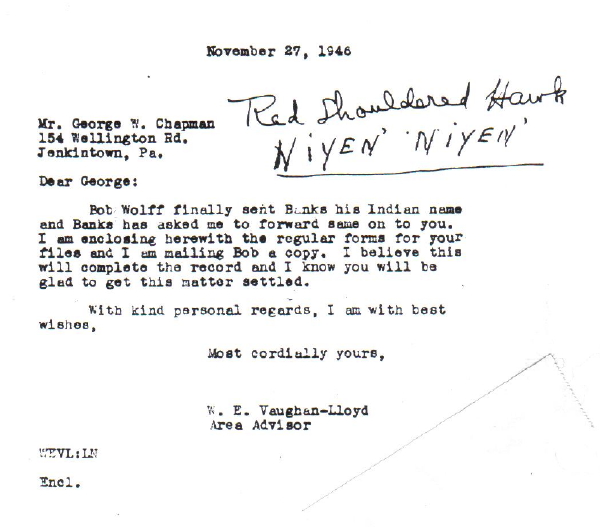
|
|
A New Career After Professional Scout Service
|
|
|
Following his work in Goldsboro, he worked for the F.E. Compton
Encyclopedia Company. Later he was representative and manager for the
American Guidance and Chronicle Guidance Publications in North and
South Carolina. He achieved considerable success with the guidance
publications and materials and enjoyed the work more than any he had
done. His contacts were with the State Departments of Public
Instruction personnel, high school administrators and counselors, and
university campuses with vocation and counseling personnel.
Bob
and Helen lived in Greenville from 1949 until 1967 when they returned
to Greensboro. At this time his territory included in addition to the
Carolinas, Georgia, Alabama, and Florida.
|
|
A Volunteer in the East Carolina Council
|
|
|
As a volunteer his interest and work in Scouting continued. In the East
Carolina Council, he was a merit badge counselor, member of the Council
Camping Committee, and Assistant Commissioner. He continued to work
with the Order of the Arrow and was invited by several lodges to speak
on the history of the OA.
After a talk to the Tali Taktaki Lodge Christmas Banquet in 1965, the Vice Chief's letter to him stated,
| |
"Your
wit and generosity were the highlights of the banquet. Your wonderful
memory of these many things which happened several years ago was
inspiring to all of us. I think that in these times of war and
rebellion we need more men with the sense of humor and ability to
remember and to get along so well with others. Your challenge of
service will always stick in my mind."
|
|
Young
people in many different circumstances were attracted to Bob. Each of
them felt his genuine interest in them. They have frequently spoiken
and written of his understanding of them personally, his kindness, his
honesty, and his wonderful wit and humor. They remember his expressing
confidence in them when they were in trouble and then giving them the
help they needed to get on the right track. He was particularly
sensitive to the needs of boys who had little financial help or little
support and guidance. Again and again, these people speak of him as the
one to whom they owe their success. Once of the men writing of Bob's
help when he was a pre-adolescent and teenager said: "I say a prayer
and thank God for letting me know such a great understanding man. What
would I have been without his help?"
|
|
|
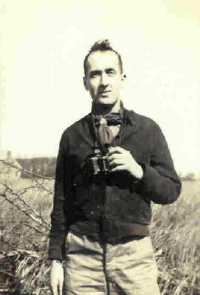
On a Bird Watch
Early 1960's
Courtesy of the
Hammerstone Scout Museum
Lillington, NC
|
|
From the study and observations of birds, Bob received much joy and
personal pleasure. Up before daylight for bird walks was a regular
activity for him. All through his life he continued to add to his
knowledge. His special interest was in water fowl and shore birds. The
proximity of Eastern North Carolina to the shores was one of the
reasons he enjoyed living in the region so much. From an early age he
participated in the annual December bird census. Copies of some of his
reports, along with letters concerning indentification of birds were
kept through the years. For many years he received from the North
Carolina and the Federal Wildlife Commissions, Collecting and Bird
Banding Permits. In return, he filed an annual report of his collecting
and banding activities.
Aycock Brown, a naturalist who lived in Manteo, was a columnist for the Greensboro Daily News and the News and Observer. He
and Bob were good friends and on occasion he invited Bob to be his
guest columnist. One column Bob wrote was a description of his visit to
the Pelican Rookery on Shell Island, about 4 miles southwest of
Okracoke. Later he went with people from the State Wildlife Commission
and they banded pelicans.
|
|
Bob
had a continuing interest in the birds on the Wildlife Refuge of Pea
Island and Mattamuskeet. This was the subject of an article he wrote as
a member of the American Ornithology Society. Other groups with which
he affiliated were the North Carolina Bird Club and the Piedmont Bird
Club in Greensboro. He was active in the campaign to have the state
legislature designate a state bird.
He
revered his friendships with Dr. Arthir Allen, Professor of Ornithology
at Cornell University and Dr. T. Gilbert Pearson, Editor in Chief of
Birds of America and former President of the National Association of
Audubon Societies. He also greatly honored the friendship of Dr. C.S.
Brimley, a noted North Carolina Ornithologist with whom he had many
bird walks in the Raleigh area.
Although
birds were his special area of expertise, all of our natural
environment held great appeal for him. He was inordinately
knowledgeable about wild flowers, plants, trees, and animals. He had a
great talent for making all of this interesting to young people.
|
|
The Bob Wolff Nature Area at Camp Bonner
|
|
|
In the preface of the orange nature booklet dedicated to Bob Wolff is written.....
| |
A tribute to Bob Wolff from a young Scout friend:
".........Bob
had a deep and lasting influence on my life as I was growing up. Much
of what success I've had, I attribute to Bob's wisdom and guidance when
I needed it. His most direct influence was helping me develop as a
nature counselor at Boy Scout summer camp. Bob always impressed me most
with the unselfish way he gave of his time, energy, and especially
himself to so many young boys year after year at summer camp. I know
that he touched thousands of live and many were greatly enriched for
it. They will continue to be a living memorial as fine citizens - to a
truly great gentleman."
|
|
|
|
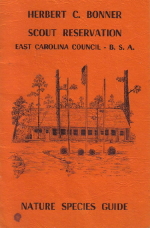
|
|
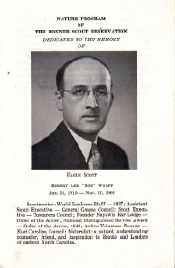
|
|
There
as a great desire to have the beauty of the area enjoyed, appreciated
and protected by Scouts and Scouters, thus honoring the man who fully
demonstrated throughout his life a genuine joy and appreciation for our
natural world and all the life within it.
Dr. Roger Billica wrote a narrative about his friendship to Bob Wolff in the spring 2009 issue of The Silver Arrowhead, a newsletter for recipients of the OA Distinguished Service Award. The article can be viewed at:
http://www.oa-bsa.org/resources/pubs/silverarrowhead/silverarrowhead_vol2iss1.pdf
|
|
|
|











